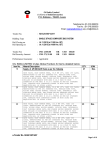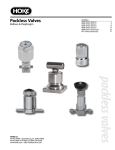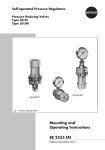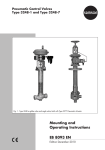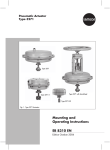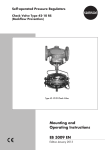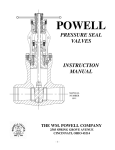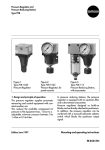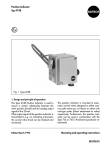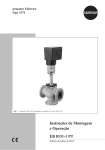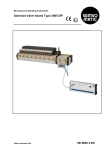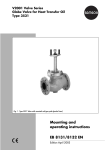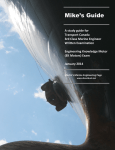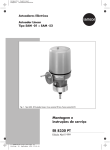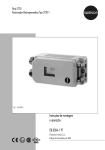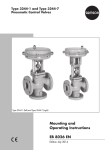Download Mounting and Operating Instructions EB 8039 EN
Transcript
Pneumatic On-off Valve Type 3351 Fig. 1 · Type 3351 Mounting and Operating Instructions EB 8039 EN Edition January 2005 Contents Contents Page 1 Design and principle of operation . . . . . . . . . . . . . . . . . . . 4 2 2.1 Installation . . . . . . . . . . . . . . . . . . . . . . . . . . . . . . . 4 Direction of flow . . . . . . . . . . . . . . . . . . . . . . . . . . . . 4 3 3.1 3.2 3.3 3.4 3.5 Maintenance – Replacing parts . . . . . . . . . . . . . . . . . . . . . 6 Disassembly for valves in DN 15 to 80 . . . . . . . . . . . . . . . . . 7 Reassembling valve in DN 15 to 80 . . . . . . . . . . . . . . . . . . . 8 Disassembly for valves in DN 100 . . . . . . . . . . . . . . . . . . . . 9 Reassembling valve in DN 100 . . . . . . . . . . . . . . . . . . . . . 9 Function test . . . . . . . . . . . . . . . . . . . . . . . . . . . . . 10 4 Description of nameplate . . . . . . . . . . . . . . . . . . . . . . . 11 5 Customer inquiries . . . . . . . . . . . . . . . . . . . . . . . . . . 11 Note! Non-electrical actuators and valves do not have their own potential ignition source according to the risk assessment in the rare incident of an operating fault, corresponding to EN 13463-1: 2001 paragraph 5.2, and therefore do not fall within the scope of the European Directive 94/9/EC. Refer to paragraph 6.3 of EN 60079-14:1977 VDE 0165 Part 1 concerning connection to equipotential bonding system. 2 EB 8039 EN Safety instructions General safety instructions 4 The control valve may only be mounted, started up or serviced by fully 4 4 4 trained and qualified personnel, observing the accepted industry codes and practices. Make sure employees or third persons are not exposed to any danger. All safety instructions and warnings in these mounting and operating instructions, particularly those concerning assembly, start-up and maintenance, must be observed. The control valves fulfill the requirements of the European Pressure Equipment Directive 97/23/EC. Valves with a CE marking have a declaration of conformity that includes information about the applied conformity assessment procedure. The corresponding declaration of conformity can be viewed and downloaded on the Internet at http://www.samson.de. For appropriate operation, make sure that the control valve is only used in areas where the operating pressure and temperatures do not exceed the operating values which are based on the valve sizing data submitted in the order. The manufacturer does not assume any responsibility for damage caused by external forces or any other external influence! Any hazards which could be caused in the control valve by the process medium, operating pressure, signal pressure or by moving parts are to be prevented by means of the appropriate measures. Proper shipping and appropriate storage of the control valve are assumed. Caution! 4 For installation and maintenance work on the valve, make sure the relevant 4 section of the pipeline is depressurized and, depending on the process medium, drained as well. If necessary, allow the control valve to cool down or warm up to reach ambient temperature prior to starting any work on the valve. Prior to performing any work on the valve, make sure the supply air and control signal are disconnected or blocked to prevent any hazards that could be caused by moving parts. EB 8039 EN 3 Design and principle of operation 1 Design and operation principle of The Type 3351 Pneumatic Control Valve consists of an on-off valve and a diaphragm actuator which can be additionally equipped with a handwheel. Depending on the whether the control valve is designed for Fail Close action or Fail Open action, the control valves can differ in the design of valve seat as well as the arrangement and design of the valve plug. 2 Any installation position can be chosen, however, we recommend horizontal installation with the actuator on top to simplify any maintenance procedures, when required. Note! The valve must be installed free of stress. If necessary, support the piping near the connections. Never attach supports to the valve or actuator. Valve with Fail Close action: The spring (5.5) closes the valve when the pressure acting on the actuator diaphragm (5.4) is reduced and upon supply air failure. The valve opens when the diaphragm (5.4) is pressurized . Valve with Fail Open action: The spring (5.5) opens the valve when the pressure acting on the actuator diaphragm (5.4) is reduced and upon supply air failure. The valve closes when the diaphragm (5.4) is pressurized. For versions with handwheel, the handwheel replaces the supply air function. In the event of supply air failure, the valve can be opened with Fail Close action against the force of the springs (5.5), and it can be closed for valves with Fail Open action. Installation Thoroughly flush the pipeline prior to installation of the valve so that welding spatter or other impurities carried along by the process medium cannot impair the tight shut-off function. 2.1 Direction of flow The direction of the medium flow in the valve depends on the process medium and the selected fail-safe action. For valves with Fail Close action, which are used to control gases and vapors, the medium must flow against the valve plug (3) in the closing direction (A → B). For liquid applications, the medium must flow into the plug (3) in the opening direction (B → A). For valves with Fail Open action, the medium flows against the plug (3) in the opening direction (A → B) irrelevant of the process medium type. 4 EB 8039 EN Installation Fail Open Fail Close 5.7 7.3 7.1 Fail Open R = 47 mm R Fail Close R = 64 mm 7.2 7 7.4 DN 100 version 6 5.8 5.7 5.4 5.6 5.9 5.5 3.3 3.2 3.1 5 1.2 5.2 4.2 4 1.1 A B Fail Open Fail Close 4.3 4.1 5.1 3 2 3 1 1 1.1 1.2 2 3 3.1 3.2 3.3 4 4.1 4.2 4.3 5 5.1 5.2 7 Valve bonnet 7.1 7.2 7.3 7.4 Diaphragm plate Nut/Lock nut Nut Milled part Valve body Flat gasket Nuts Seat Plug assembly Plug stem Lock nut Washer Packing Spring PTFE V-ring packing Washer Valve bonnet Guide bushing Threaded bushing 5.4 Diaphragm 5.5 Spring 5.6 Spring plate 5.7 Top diaphragm case 5.8 Loading pressure connection 5.9 Nuts, bolts and washers 6 Handwheel (optional) Fig. 2 · Sectional drawings EB 8039 EN 5 Maintenance – Replacing parts 3 Maintenance parts – Replacing The control valve is subject to natural wear in particular at the seat, plug, and packing. Depending on the operating conditions, the valve must be checked at regular intervals to prevent problems occurring. If leakage occurs, this could be caused by a defective packing. If the valve does not seal properly, the tight shut-off may be impeded by dirt or other impurities caught between the seat and plug, or by damaged seating surfaces. Remove the parts, clean them thoroughly and replace them with new ones, if necessary. Before performing any work on the valve, you must disassemble the control valve. You only need to remove the top diaphragm case when the actuator is defective due to a damaged diaphragm. Caution! Before servicing or disassembling the control valve, depressurize the concerned section of the plant and drain it. Wait until the medium has cooled down, if necessary. As valves are not free of dead cavities, remember that there might still be residual media in the valve. This particularly applies for valve version with bellows seal or insulating section. It is recommended to remove the valve from the pipeline for maintenance. Spring Mounting device Spacer used for disassembly Washer Fig. 3 · Mounting device DN 15 to 80 6 EB 8039 EN Alignment of spring Maintenance – Replacing parts Note! Before servicing or disassembling the control valve, disconnect and shut off the supply air. The procedures to disassemble the valve with Fail Close action and the valve with Fail Open action are not the same due to the plug arrangement. A mounting device (see Fig. 3 and Table 1) is needed as the spring (5.5) in the actuator is preloaded. To take out the seat ring, a special seat tool (Table 1) is necessary. Refer to Table 2 for the required tightening torques. 3.1 Disassembly for valves in DN 15 to 80 1. Remove nuts and bolts on the actuator. For versions with handwheel, turn the wheel in order to remove any tension acting on the spring plate (5.6). Lift off diaphragm case (5.7) and remove diaphragm. 2. Place spacer (approx. 5 mm) on the spring plate as shown in Fig. 3. Place mounting device on top and fasten using three fastening nuts and bolts. Tighten nuts so that the spring plate (5.6) is preloaded evenly. As a result, the plug (3) starts to move away from the seat. 3. Loosen threaded bushing (5.2) completely. Spray the lock nut (3.2) stuck to the plug stem with adhesive as well as the ends of the plug stem with solvent. Use a hot-air gun to soften the adhesive 4. 5. 6. 7. and loosen the lock nut (3.2). Position socket wrench or hex screwdriver (DN 65/80) and carefully turn the plug stem clockwise until its height has changed by approx. 6 mm. Loosen fastening bolts of the mounting device as well as the plug stem step-by-step until the plug stem is unscrewed from out of the spring plate (5.6). Remove spring plate and spring, unscrew lock nut (3.2). Remove valve bonnet (5) from valve body and carefully pull up, for version with Fail Close action over the plug stem, and for version with Fail Open action together with the plug stem. If you want to replace the seat and/or the plug for the version with Fail Close action, the seat needs to be removed. Position the seat wrench (Table 1) (over the plug stem for version with Fail Close action) on the seat, so that its recesses are aligned with the seat's spigots. Insert the guide part of the seat wrench in the body and unscrew seat with a suitable tool extension. Thoroughly clean all parts, remove flat gasket (1.1). If the packing leaks, unscrew the threaded bushing (5.2) in the valve bonnet and remove the individual parts, such as V-ring packing (4.2), washer (4.3), and spring (4.1). When replacing the plug with a new one, the packing rings (4.2) need to be replaced with new ones as well. EB 8039 EN 7 Maintenance – Replacing parts Thoroughly clean all parts as well as the packing chamber. 3.2 Reassembling valve in DN 15 to 80 1. For version with Fail Close action, first place the plug in the body, for version with Fail Open action, push plug into the valve bonnet. Carefully degrease the plug stem thread. 2. Apply sealant (order no. 8150-0119) to the seat and screw it in using the seat wrench (observe tightening torque according to Table 1.) 3. Packing: first insert spring (4.1) and washer (4.3) in the packing chamber, then the V-ring packing parts (4.2) after applying lubricant (order no. 8150-0111) to them. Loosely screw in threaded bushing (5.2). 4. Insert flat gasket (1.1) into the body. Place the valve bonnet (5) on the body, for version with Fail Close action, lift the plug stem and carefully guide through the packing. Fasten down valve bonnet by tightening the nuts (1.2) evenly. Screw lock nut (3.2) onto the plug stem until the end of the thread, place washer (3.3) on top. 5. Insert spring (5.5) into the valve bonnet and align according to Fig. 3. Screw spring plate (5.6) on the plug stem by hand, until it rests on the spring. Align the spring plate cams so that the 8 EB 8039 EN plate is positioned above the recess of the diaphragm case. 6. Screw on mounting device. Evenly tighten fastening bolts until the spring is preloaded approx. 6 mm by the spring plate. 7. Apply adhesive (order no. 8121-9014) to the plug stem thread. Place the socket wrench or hex screwdriver to turn the plug stem counterclockwise as far as it will go. For version with Fail Close action, continue to preload the mounting device step-by-step until it's three stop bushings touch the diaphragm case. For version with Fail Open action, continue to preload the mounting device step-by-step until it has a distance of approx. 2 mm from the diaphragm case. Turn plug in this position counterclockwise as far as it will go, then tighten lock nut (3.2). Remove mounting device. 8. Insert diaphragm (5.4), place diaphragm case on top and tighten evenly. Tighten threaded bushing (5.2) as far as it will go. Maintenance – Replacing parts 3.3 Disassembly for valves in DN 100 1. Remove nuts and bolts on the actuator. For versions with handwheel, turn the wheel in order to remove any tension acting on the diaphragm plate (7.1). Lift off diaphragm case (5.7). 2. Loosen nut (7.3) and unscrew it while holding the plug stem stationary at the milled part with an open wrench (SW 14). 3- Remove diaphragm plate and springs. Unscrew nut (7.2) together with lock nut. 4. Carefully pull valve bonnet (7) upwards , for version with Fail Close action over the plug stem, and for version with Fail Open action together with the plug stem. 5. If you want to replace the seat and/or the plug for the version with Fail Close action, the seat needs to be removed. Position the seat wrench (Table 1) (over the plug stem for version with Fail Close action) on the seat so that its recesses are aligned with the seat's spigots. Insert the guide part of the seat wrench in the body and unscrew seat with a suitable tool extension. 6. Thoroughly clean all parts, remove flat gasket (1.1). If the packing leaks, unscrew the threaded bushing (5.2) in the valve bonnet and remove the individual parts, such as V-ring packing (4.2), washer (4.3), and spring (4.1). When replacing the plug with a new one, the packing rings (4.2) need to be replaced with new ones as well. Thoroughly clean all parts as well as the packing chamber. 3.4 Reassembling valves in DN 100 1. For version with Fail Close action, first place the plug in the body, for version with Fail Open action, push plug into the valve bonnet. 2. Apply sealant (order no. 8150-0119) to the seat and screw it in using the seat wrench (observe tightening torque according to Table 1.) 3. Packing: first insert spring (4.1) and washer (4.3) in the packing chamber, then the V-ring packing parts (4.2) after applying lubricant (order no. 8150-0111) to them. Loosely screw in threaded bushing (5.2). 4. Insert flat gasket (1.1) into the body. Place the valve bonnet (5) on the body, for version with Fail Close action lift the plug stem and carefully guide through the packing. Fasten down valve bonnet by tightening the nuts (1.2) evenly. Screw lock nut (3.2) onto the plug stem until the end of the thread, place washer (3.3) on top. 5. Screw nut and lock nut onto the plug stem according to the dimension R (Fig. 2) and tighten. On doing so, make sure the plug is resting on the seat. EB 8039 EN 9 Maintenance – Replacing parts 6. Insert springs into the valve bonnet and align the end of the springs towards the middle. 7. Place diaphragm plate on the end of the plug stem (3.1), while pulling the plug stem as far as possible out of the valve. Screw nut (7.3) on tight, while holding the plug stem stationary at the milled part with an open wrench (SW 14). 8. Align the holes in the diaphragm, place diaphragm case on top and fasten tight by tightening the bolt (5.9) evenly. 3.5 Valve with Fail Close action: The valve must be closed when 0 bar air pressure is applied, it must start to open when at least 3 bar is applied and be completely open at 6 bar. Valve with Fail Open action: The valve must still be open when 0.5 bar air pressure is applied and completely closed at 4.5 bar. Function test After reassembling the valve, we recommend performing a function test to check whether the valve functions properly. To proceed, connect a suitable source of compressed air to the loading pressure connection on the diaphragm case. Order no. Table 1 Nominal size DN 15...25 1/2”...1” DN 32...50 1 1/2”...2” DN 65 and 80 4” Mounting device 1281-0063 1281-0037 1281-0038 Seat wrench 1281-0040 1281-0041 1281-0042 1281-0043 Wrench extension Fail Close action 1281-0044 1281-0045 1281-0046 1281-0051 1) Tightening torque 150 Nm 400 Nm 850 Nm 1050 Nm Tightening torque Table 2 Nuts (1.2) Packing (5.2) Nuts (5.9) 1) M10/20 Nm M12/35 Nm M16/90 Nm M20/170 Nm M20x1.5/20 Nm M20x1.5/80 Nm M26x1.5/110 Nm M26x1.5/110 N M6/13 Nm M8/18 Nm M8/18 Nm M8/18 Nm On using a torque multiplier with 1” square end. 10 EB 8039 EN DN 100 Description of nameplate 4 Description of nameplate 5 Customer inquiries Please submit the following details: SAMSON 3 -4 1 7 2 11 5 6 8 9 13 16 1 CE marking or "Art. 3, Abs.3" (see article 3, § 3 of PED), where applicable 2 Identification no. of notified body, fluid group and category, where applicable 3 Type designation 4 5 6 7 8 Modification index of valve Material Year of manufacture Nominal size: DIN: DN, ANSI: Size Permissible excess operating pressure at room temperature DIN: bar, ANSI: psi 9 Serial number 11 Flow coefficient: DIN: KVS, ANSI: CV 13 Sealing: ME Metal, STV Solid Stellite, ST Stellited, NI Nickel-plated, IN with PTFE/stainless steel soft sealing PT with PTFE soft sealing, PK with PEEK soft sealing 16 Country of manufacture 4 Order number 4 Type, model number, nominal size and version of the valve 4 Pressure and temperature of the process medium 4 Flow rate in m3/h 4 Minimum and maximum signal pressure 4 Has a strainer been installed? 4 Installation drawing Dimensions and weights Refer to the Data Sheet T 8039 EN for the dimensions and weights of the various valve versions. Fig. 4 · Valve nameplate EB 8039 EN 11 EB 8039 EN S/Z 2005-02 SAMSON AG ⋅ MESS- UND REGELTECHNIK Weismüllerstraße 3 ⋅ 60314 Frankfurt am Main ⋅ Germany Phone +49 69 4009-0 ⋅ Fax +49 69 4009-1507 Internet: http://www.samson.de













